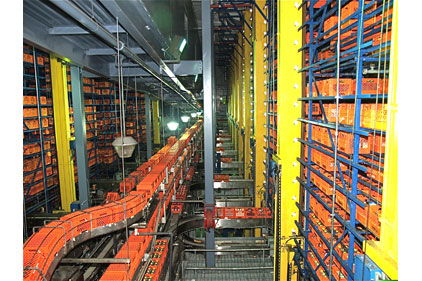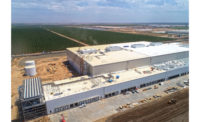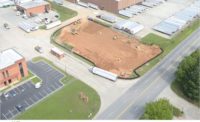Wawa Maintains a High-Throughput Distribution Center

The name Wawa is well known throughout the mid-Atlantic states. Its dairy convenience stores are seemingly on every major thoroughfare, and with 400 million customers annually, it presents a serious logistics challenge to keep the stores stocked. Nowhere is this challenge more critical than with the warehousing and distribution of its fresh liquid milk products. Few consumer food products require more demanding time and temperature controls from production through warehousing and distribution to their arrival on retailers’ shelves than dairy products. Fresh liquid milk must be distributed within days, and some of Wawa’s milk products are moved through its distribution center and shipped within a few hours after being filled and packaged.
customers annually, it presents a serious logistics challenge to keep the stores stocked. Nowhere is this challenge more critical than with the warehousing and distribution of its fresh liquid milk products. Few consumer food products require more demanding time and temperature controls from production through warehousing and distribution to their arrival on retailers’ shelves than dairy products. Fresh liquid milk must be distributed within days, and some of Wawa’s milk products are moved through its distribution center and shipped within a few hours after being filled and packaged.
The need for automation
Achieving this speed of throughput became increasingly more difficult for Wawa as its business continued to expand. The company added more new stores, and its manually-operated chilled warehouse ran out of room. Its production outpaced its storage capacity. The company’s products were now being produced, staged on the warehouse floor and quickly shipped to make room for milk, teas and juices that were newly coming off the line. The distribution center’s storage space surpassed maximum capacity, and it ran out of space on the floor to stage products.
“The challenge was where to put the product,” says David Mann, manager of Wawa’s beverage warehouse. “Where do you store it? Basically, the plant would produce to ship. It wouldn’t ever produce more than could be shipped over the next day. There wasn’t any more room on the floor to stage it.”
To find a solution to this logistics challenge and facilitate the need for speed and high throughput, Wawa brought in Swisslog Warehouse & Distribution Solutions, Newport News, Va., to engineer and install a system that would meet the company’s demanding requirements. Swisslog put into place a streamlined and highly automated storage and distribution solution that provides adequate storage capability and better ensures timely and accurate handling for all of its liquid products, including milk, teas and juices.
High-bay warehouse
Wawa’s solution focused on building a high-bay refrigerated warehouse, serviced by 16 high-speed, fully-automated storage and retrieval mini-load stacker cranes that efficiently move crates in and out of the 35-vertical-foot, high-bay racking. The high-bay/mini-load system receives crates filled with milk, teas and juices from upstream production, stores up to 80,000 crates in the system, then selects and releases crates to fill pick orders for shipping. The storage and retrieval functions are completely automated, without the need for direct human intervention.
There are major benefits for Wawa’s warehouse switching from a manual to an automated high-bay chilled facility—maximized building volume and increased cost efficiency. Wawa’s high-bay can handle a greater number of crates, but on a much smaller footprint. Of equal importance, the footprint reduction becomes an increasingly important factor in energy savings since much of the cold loss in a chilled warehouses occurs through the roof. Chilled warehouses are giant insulated refrigerators that extract heat to produce a chilled environment. The removal of heat comes at a hefty energy cost. Having a smaller roof footprint in a refrigerated warehouse presents a considerably better energy solution.
Those high-bay, chilled warehouses that are the most energy and cost efficient have achieved a high density of space utilization. This means they have a space configuration that allows for the maximum number of crate positions to fit into the facility.
Wawa’s high-bay optimizes cubic space usage, not only by its vertical stacking capability, but also by minimizing aisle cubic footage. By eliminating the need for forklift trucks, aisles can be made significantly more narrow, allowing 12-foot-wide aisles to become just 5-foot wide. This space can then be used for more crate positions.
Mini-load automated storage and retrieval system
The Swisslog mini-load stacker cranes at Wawa are light, high-speed, computer-controlled automated storage and retrieval systems (ASRS) for automatically depositing, storing and retrieving crates from defined storage locations. They allow inventory to be moved quickly, safely and precisely within the chilled warehouse.
The cranes provide a uniquely flexible and modular design that is equipped with a duo fork capable for transporting up to eight crates simultaneously, both for putting product into the high bay and for retrieval for picking. When a pick order is initiated, a crane moves to the designated high-bay location, selects the crates and deposits them on a conveyor at a pick station where 54-crate blocks are prepared in exact required shipping order sequence. The crane then automatically moves to fulfill the next order.
Wawa’s mini-load cranes use an integrated controls architecture for material flow control, enabling optimized speed and precision positioning. These controls instruct the cranes where to place incoming crates and where to retrieve them for picking.
The direct integration of the warehouse management system (WMS) ensures that Wawa’s mini-load stacker cranes always select the correct inventory and item numbers by rotating the product inventory properly.
The high-bay/mini-load system provides rapid response to Wawa’s storage and retrieval needs.
Warehouse management system with load tracking
The dairy’s WMS, in coordination with PLCs in the mini-load cranes, is capable of monitoring batch numbers, production dates and weight as the crates are stored and moved through the facility.
“Everything that we operate in the warehouse is driven by the WMS,” Mann says. “From the moment the products come off the production line, through storage and through shipping.”
The WMS knows precisely what the product SKUs are and how many of those crates are entered into storage. Such integrated WMS ensures optimized storage for Wawa by distributing SKUs over its 16 aisles, improving delivery execution and maximizing labor resources.
The WMS is integrated with Wawa’s ERP to monitor and streamline orders automatically straight through to shipping.
System performance
Wawa’s distribution facility can automatically handle 42,000 crates of liquid products daily (2,400 per hour), operating with a system uptime rate exceeding 99% and an order accuracy rate topping 99.9%, while functioning in a chilled 35°F environment.
“The high-bay and automation has enabled us to do larger runs,” explains Mann. “And we do fewer runs of product because of the additional storage.”
The automated solution was initially put into operation in late 2000, but has received ongoing upgrades to maintain its performance and efficiency. Operating 20 hours per day, six days a week, the mini-load cranes run almost continuously with virtually no loss of performance. Wawa maintains one Swisslog technician per shift on site to ensure the 16 mini-load cranes and WMS are operating at peak performance and to regularly implement system upgrades.
“After many years of usage, the Swisslog mini-loads and warehouse management system are still performing very well,” continues Mann. “We have done numerous upgrades on the systems. Over the years we have had no significant downtime. The uptime on the equipment is outstanding.”
Looking for a reprint of this article?
From high-res PDFs to custom plaques, order your copy today!







